Click the headers of the accordions below to navigate to different sections of this page:
Introduction to the Newly Updated School Directory Management Portal
The School Directory (SD) Management Portal (formerly called the School Directory Update application) has been updated for your convenience and to give it a more modern look, matching its ‘sister’ application, the Wisconsin School Directory Public Portal.
It is very important that every tile appearing on the home screen of the Management Portal is clicked, read, reviewed and edited as needed so that DPI has accurate and current data.
The tiles appearing on a home screen, and their sub-tiles/screens for a public school district, are listed within each accordion below.
NOTE: The person making changes to the School Directory Management Portal application must have the user role of “Directory Update." If you do not hold this user role, you must request it from your district’s District Security Administrator (DSA) or your district’s Application Administrator. You can make the request, and they can assign this role to you all within WISEsecure.
The 'Opening' screen provides users with tips and general knowledge. Read over the information and then click the "Go to Home Page" button.

Printable Companion Checklist
We are pleased to present you with this printable task checklist to help make sure you accomplish all of the required updates in School Directory Management Portal. Please use it as a companion document along along with this user guide. The checklist does not provide tutorial details. This user guide is robust with instructions and screenshots. The checklist helps to ensure you've accomplished all of the tasks.
User Guide
- The Home Screen
-
“Application Open/Closed”
Each year the information submitted to DPI from the school Directory applications is used for a wide variety of purposes. Many people throughout the state create external data requests for Directory based information. Additionally, Directory information is compiled in over 80 reports that get submitted to the U.S. Department of Education.

In order to process data as it changes from one school year to the next, the Wisconsin School Directory Management Portal application has to ‘close,’ meaning that it cannot accept submitted data for that time. This annual event usually takes place sometime between mid-December until about mid-January, when the application re-opens.
If you log into the application during a ‘closed’ period, the icon that appears green and says “Application Open” in the screenshot above will instead be a red color and will state “Application closed.” While you will be able to log in and view the home screen, as long as the icon reads “Application Closed”, users will not be able to make any data edits within the application.
If you have an urgent change to be made to your Directory information, but the application is Closed, please submit a Help Ticket. Select ‘School Directory Updates” from the application drop-down list, and explain your needs in the free text field.
It is also important to note that when the School Directory Management Portal reopens (again, roughly in January of each calendar year), that the Directory is then accepting information for the following school year. For example, when the School Directory Management Portal opens in February of 2024, it is open to accept data for the 2024-25 school year (even though February, 2024 is still in the calendar time frame for the 2023-24 school year).
“Manage Data” Icon and the “Submit Review” Button
Follow all the steps provided within the User Guide sections below. To edit and update information in the School Directory Management Portal, you'll need to click the purple pencil icon in the upper right corner of each tile that appears on your home screen. This is referred to as a 'Manage Data' icon through the user guide. Clicking this icon will bring you to screens where you can edit and update your School Directory data.
Do not click the 'Submit Review' button until you have reviewed and updated data on all tiles and screens within the School Directory Management Portal application. If you submit data that has not been reviewed, you will likely receive validation messages.
The Home Screen and Breadcrumbs as Navigation:
The Home screen of the SD Management Portal displays tiles, each with a unique header. Each tile needs to be reviewed annually. Smaller changes that occur through the year can be made periodically during the application’s “Open” time frame. To edit information on any tile, you must click the ‘Manage’ icon: a small pencil in the upper right corner of each tile. Clicking the Manage icon in the upper right corner of each tile will open a new screen. All screens are editable except for the basic information screen.
A message across the top of the Home screen will inform you of the progress of your data review. If you have not started your data review, the Home screen will indicate that you data has not been verified.

Once you begin your data review, the Home screen message will change to indicate your progress.

The tile headers are used to create the ‘breadcrumbs’. Breadcrumbs are a list of screen names, separated by a ‘caret’ (>) symbol. They will appear across the top of every screen. Use the breadcrumbs to navigate through this application.

Clicking a word in the breadcrumb trail will take you to that screen. The breadcrumbs displayed are dynamic and change as you navigate screens. The breadcrumb path always starts from the ‘Home’ screen. Click the word ‘Home’ to return to the home screen at any time.
The number of tiles appearing on the home screen depends on the type of agency accessing the SD Management Portal (i.e., public LEA, CESA, County CDEB, private school, State Agency Institute, or ICS Governance Board). For information on Agency Types that report through the School Directory Management Portal, visit the School Directory Management Portal: User Guide landing page.
Every time the “Manage” icon appears in this user guide, you will get a numbered list of tasks to complete on that screen:
To Manage:

- Pay attention to the “Manage” icon throughout this user guide.
- Start by updating the Basic Information tile/screen.
- Basic Information Tile
-
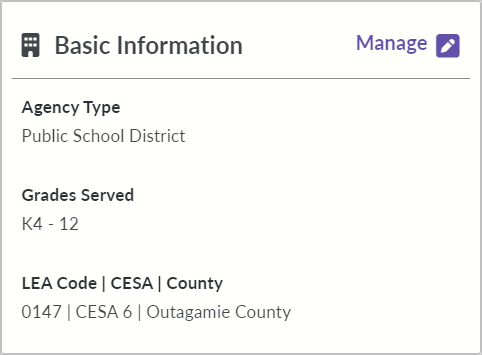 This is a view only tile. It does allow users to click the “Manage” button, but the information displayed on this tile must be edited at the school level, using the Public Schools tile.
This is a view only tile. It does allow users to click the “Manage” button, but the information displayed on this tile must be edited at the school level, using the Public Schools tile.The information on this tile and its corresponding screen is district level information.
Basic Information Tile Screen
This is a view only screen. Changes needed to the items bolded at the top (School District, Legal Name, Agency Type, LEA Code, CESA, and County) must be requested through a Help Ticket. The person submitting this ticket must have the user role of “Directory Update” because this role signifies they have authority to request these changes. This is indicated by the message highlighted across the top of the dark gray section of the screen:

- Agency Name data element page
- Legal Name data element page
- Agency Types that report through the School Directory Management Portal are defined on the School Directory Management Portal: User Guide landing page.
- LEA Code data element page
- CESA data element page
- County data element page
-
Customer Services Team Help Ticket: click this if you need information changed on the School Directory School Basic Information screen that you cannot edit yourself.
Low Grade and High Grade:
These values are set based on the parameters given from each of the schools within your district. Changes are made on screens within the Public Schools tile by selecting the specific schools from the listing. More details are available within the Public Schools tile section of this user guide. Please read that section carefully.

NOTE: The lowest possible grade is four-year-old kindergarten. PK is not a grade level, as it is not defined as a grade by state statute 115.02. More information in the Educational Service section.
- Visit the Low grade/High grade data element page for more information.
- Visit the Educational Service (PK) data element page for more details on PK.
Educational Service
PK is a federal requirement under FAPE (free appropriate public education) that must be offered by public schools/districts. As explained above, PK is not a grade level, as it is not defined as a grade by state statute 115.02. The lowest possible grade is four-year-old kindergarten.

All elementary and combined schools located in a public school district are required to provide PK services.
Public school districts that have elementary schools are obligated by both federal and state legislature to become FAPE responsible for students continuing their IEP and special education services after exiting County (CDEB) services.
Any school that offers kindergarten (KG or K4) as a low grade by default must also offer PK.
Unified high schools, high schools and middle schools should not offer PK services.
- Visit the Educational Service (PK) data element page for more details on PK.
- Visit the Grade Level Placement data element page for more details on PK.
Grades Offered:
You’ll notice an expander icon for this section. It looks like a ‘plus’ sign. The plus sign indicates there is more to see. Once clicked, the window expands and displays a list of all the grade levels offered across all the schools within your school district, again, based on the parameters given from each of the schools within your district.
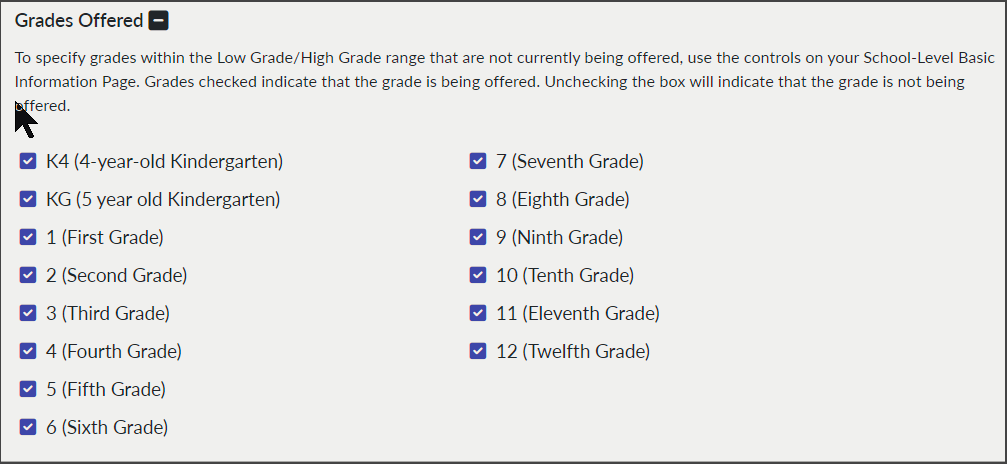
You’ll need to make changes to grade levels and PK services offered at the school level. To do so, click ‘Home’ on the breadcrumbs to return to the home screen, clicking on the Public Schools tile, and then selecting the specific schools from the listing. More details are available within the Public Schools tile section of this user guide.
To Manage:

- Submit a Customer Services Team Help Ticket if any of the following are incorrect on your screen:
- School District, Legal Name, Agency Type, LEA Code, CESA, and County
- Low Grade, High Grade: Adjust low grade and high grade later, when you get to the Public Schools tile/screen.
- Educational Service (PK) Select: Yes or No.
- PK is a federal requirement under FAPE(free appropriate public education) that must be offered by public schools/districts. All elementary and combined schools located in a public school district are required to provide PK services. This will be adjusted with the school level.
- Grades Offered: Adjust grades offered later, when you get to the Public Schools tile/screen.
- Click ‘Home’ from the breadcrumbs, and move on to the Address and Contact Tile on the home screen.
- Address and Contact Tile
-
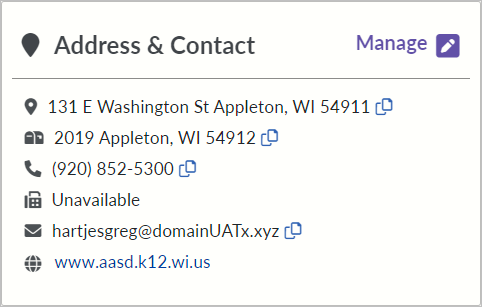 The Address and Contacts tile is below the Basic Information tile on the home screen.
The Address and Contacts tile is below the Basic Information tile on the home screen.The information on this tile and its corresponding screen is district level information.
Update Address and Contact Tile Screen
This screen is editable. Changes need to be made to any and all fields that require updating.
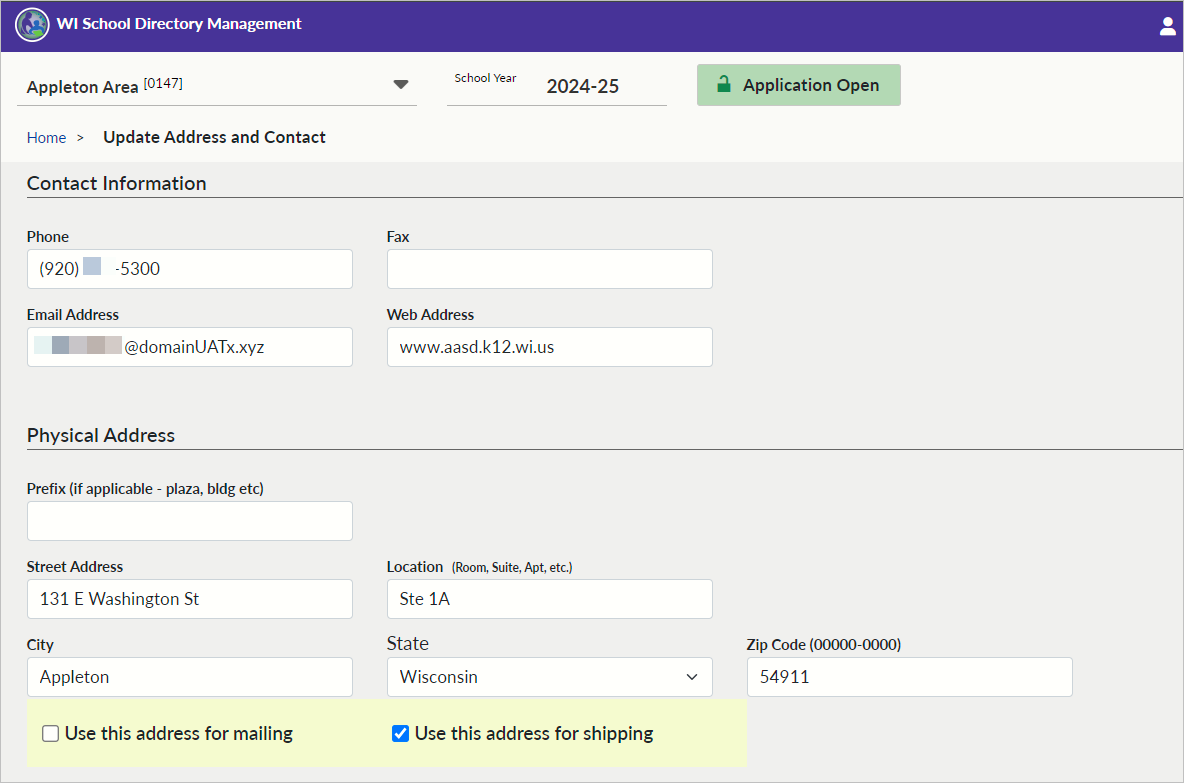
For the Contact Information section, remember to provide district level information for the following fields: Phone, Fax, Email, Web address.
- For more details about these fields, please visit the Contact Information data element page.
To Manage:

-
Review the accuracy of your contact information at the district level. This should be information for the District/Central Offices, or for the District Administrator:
-
Phone,
Fax,
Email address,
Web address/URL for the district webpage.
-
NOTE: For public school districts, if contact information is provided for the District Administrator (also known as the District Superintendent), and not the front office, make sure this information matches the name of the person listed on the home screen Staff Contacts tile.
There are also three address types to manage on this screen: physical, mailing, and shipping.
For the Physical Address section, remember to provide district level information for the following fields: Prefix, Street Address, Location, City, State, Zip Code.
- For more details about these fields, please visit the Address data element page.
Notice the boxes at the end of the physical address section. Some public school districts also use their agency level physical address (e.g., ‘Central Office’ or ‘District Office’ address) as the mailing address and the shipping address for the district.
You may choose to check one, both, or neither of these boxes as they apply to your district level needs.
- Mailing Address: check box available if same as physical address
- Shipping Address: check box available if same as physical address
If both boxes are left unchecked, you will need to enter information for both the mailing and shipping address.
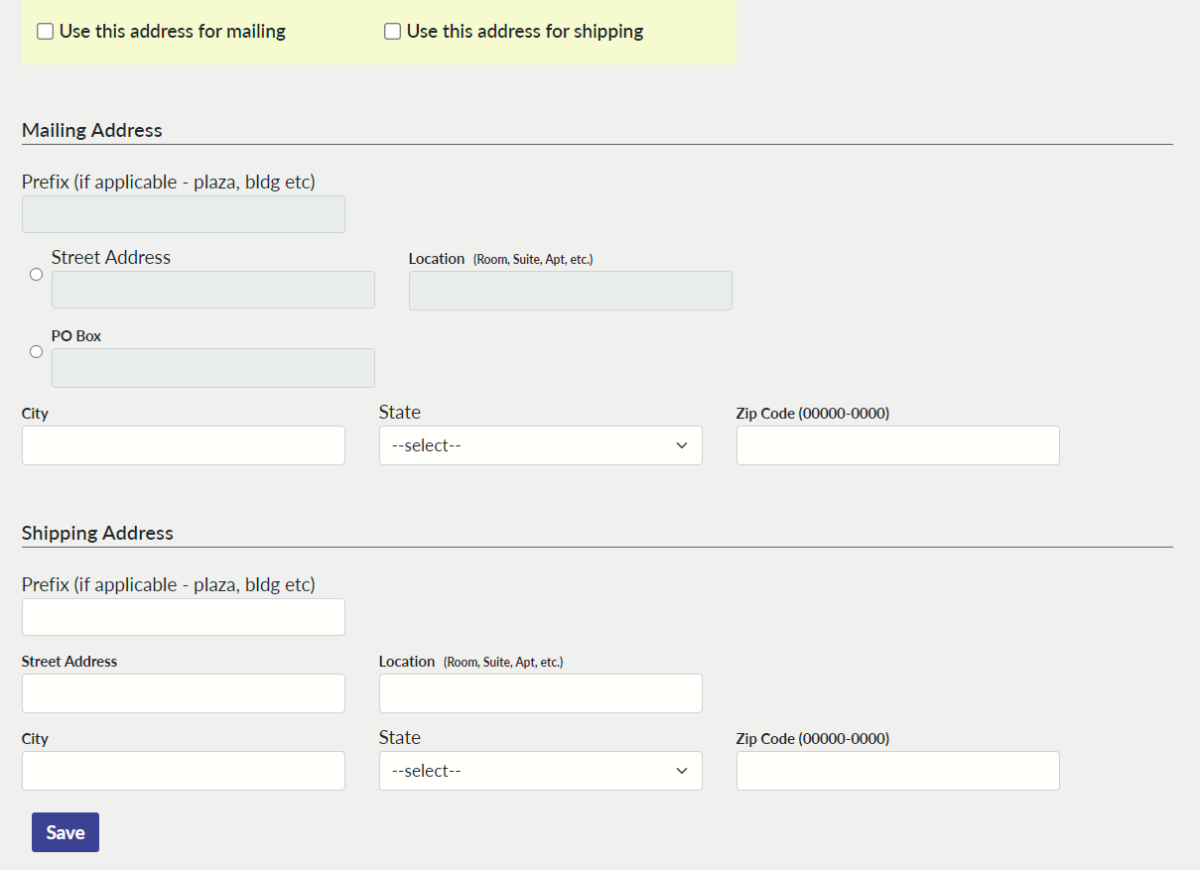
To Manage:

-
Review the accuracy of your addresses at the district level.
-
Make sure you follow the details provided about location if your district's location is in a difficult to locate area.
-
Either click the buttons to make the mailing/shipping address the same as the mailing address, or enter separate mailing/shipping address information.
-
Save changes.
-
Click ‘Home’ from the breadcrumbs, and move on to the Staff Contacts tile.
- Staff Contacts Tile
-
 The Staff Contacts tile displays the district level contact that was provided on the previous tile, the Address and Contact Person tile. This should be the person holding the role with the most authority within your school district. For public school districts, the person listed here should be the District Administrator (also known as the District Superintendent).
The Staff Contacts tile displays the district level contact that was provided on the previous tile, the Address and Contact Person tile. This should be the person holding the role with the most authority within your school district. For public school districts, the person listed here should be the District Administrator (also known as the District Superintendent).This tile brings you to the Staff Contacts screen. There are a number of mandatory contact types required by DPI. If you are missing any, you will see a notification on the home screen Staff Contacts tile, as is displayed on this example screenshot.
Mandatory Contacts Tile Screen
This screen is editable. Make changes to any and all fields that require updating. Add or save any notifications posted across the top of the screen for missing contact types.
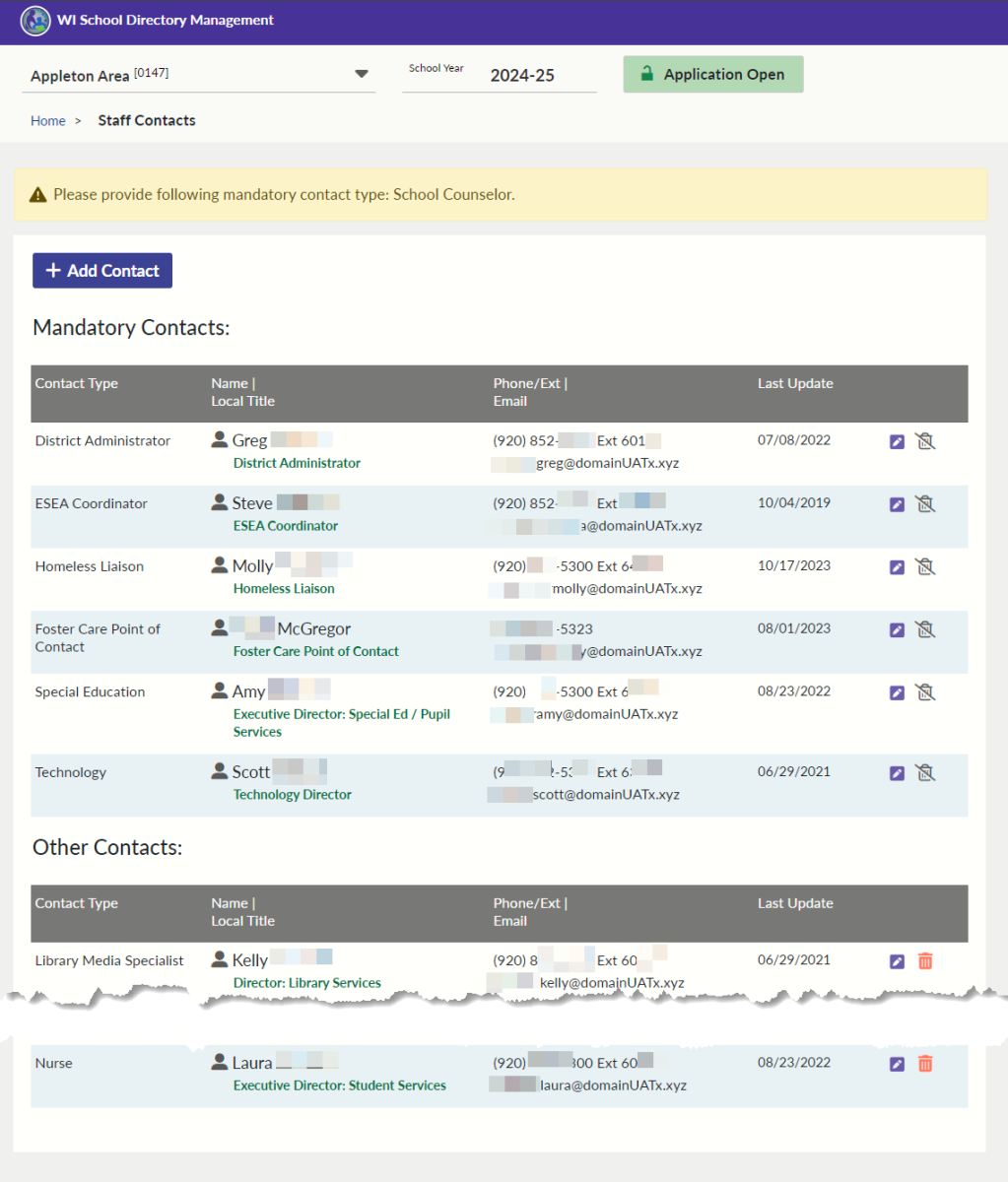
For the Mandatory Contacts section, remember that this is still information required for the district level. Make sure you are not entering school level contacts. However, in some smaller sized LEAs, there may be some overlap in positions (i.e., one person may hold multiple position titles).
Notice the validation message on the screenshot, indicating that this agency is missing the Mandatory Contact type of School/Guidance Counselor.
Mandatory Contacts for a Public School District Include:- District Administrator (also known as the District Superintendent)
- ESEA Coordinator
- Foster Care Point of Contact
- Guidance Counselor
- Homeless Liaison
- Special Education Point of Contact
- Technology Point of Contact
- Visit the Staff/Mandatory Contacts data element page for more information.
 Based on state statutes and other regulations, collecting contact information from various staff positions is required of DPI. These positions can and should be edited to ensure you submit current and accurate contact information to DPI. These same contacts cannot be deleted because they are required. As such, the edit icon is visible, but the trash can (‘delete’) icon is not available. When a specific contact type, such as the District Administrator, displays these icons, it indicates that it is a required position.
Based on state statutes and other regulations, collecting contact information from various staff positions is required of DPI. These positions can and should be edited to ensure you submit current and accurate contact information to DPI. These same contacts cannot be deleted because they are required. As such, the edit icon is visible, but the trash can (‘delete’) icon is not available. When a specific contact type, such as the District Administrator, displays these icons, it indicates that it is a required position.To Manage:

-
Review the accuracy of your mandatory contact information.
-
Click the purple edit icon to make changes.
-
Click the “+Add Contact” button to add any missing mandatory contacts. Steps on how to add contacts provided below.
Add Contacts Screen
 Each Agency Type has a specific list of mandatory contacts, as listed above. If your district does not have anyone listed for a given mandatory contact, you will need to provide the information into the Directory. You can do this by clicking the “+ Add Contact” button. Once you click the “+ Add Contact” button from the Staff Contacts screen, the Add Contacts screen will display. This should be annotated in the breadcrumbs: Home > Staff Contacts > Add Contact.
Each Agency Type has a specific list of mandatory contacts, as listed above. If your district does not have anyone listed for a given mandatory contact, you will need to provide the information into the Directory. You can do this by clicking the “+ Add Contact” button. Once you click the “+ Add Contact” button from the Staff Contacts screen, the Add Contacts screen will display. This should be annotated in the breadcrumbs: Home > Staff Contacts > Add Contact.- Visit the Staff/Mandatory Contacts data element page for more information.
To add a new contact, complete the following steps:
- Select the Contact Type for all required mandatory contacts, especially if they are missing.
- Select an appropriate Local Title. If your specific Local Title is not available in the list, please submit a Help Ticket to the Customer Services Team.
- Enter: First Name*, Last Name*, Middle Name, Gender, Suffix, Position Status*, Phone Number*, Phone Extension, Fax Number, and Email* for the current contact person. Items marked with an asterisk are required.
- For more information, visit the Staff/Mandatory Contact Type data element page.
- For position Status, if the position is neither vacant nor an interim, leave that field blank.
- Below these fields there will be three buttons: Cancel, Clear, Add.
- Click the “Add” button to save the new Mandatory Contact.
To Manage:

-
Add all required contacts.
-
Return to the Staff Contacts screen using the breadcrumbs to make sure your new contact appears in the listing.
-
Repeat as needed until all mandatory contacts are listed.
-
Return to the Staff Contacts screen using the breadcrumbs to review the Other Contacts section.
Other Contacts
Below the list of mandatory contacts are additional positions that you can post as other contacts. Again, make sure you are only adding district level contacts on this screen.
To Manage:

-
Ensure all other contacts listed are accurate for the current school year.
-
Edit or delete as needed for an accurate display of agency level staff positions.
- OPTIONAL: Add additional other contacts.
-
Click ‘Home’ from the breadcrumbs, and move on to the Kindergarten Schedule tile.
-
Kindergarten Schedule Tile
-
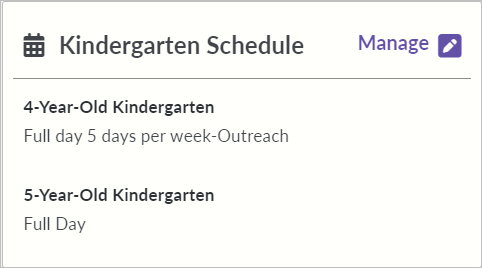 This Kindergarten Schedule tile on the home screen is the bottom, middle tile. This tile displays a school district’s four-year-old kindergarten and five-year-old kindergarten schedules. The information on this tile and its corresponding screen is district level information.
This Kindergarten Schedule tile on the home screen is the bottom, middle tile. This tile displays a school district’s four-year-old kindergarten and five-year-old kindergarten schedules. The information on this tile and its corresponding screen is district level information.Kindergarten Schedule Tile Screen
This screen is editable. Changes need to be made to each of the three sections:
- 4-Year-Old Kindergarten
- Location of 4-Year-Old Kindergarten: Program Setting Definitions
- 5-Year-Old Kindergarten
The options you select here will appear on the Kindergarten Schedule tile that is on the home screen.
This is a unique screen from the others in that it contains several drop-down menus, each one requiring you to make a selection about the kindergarten options available at the agency level.
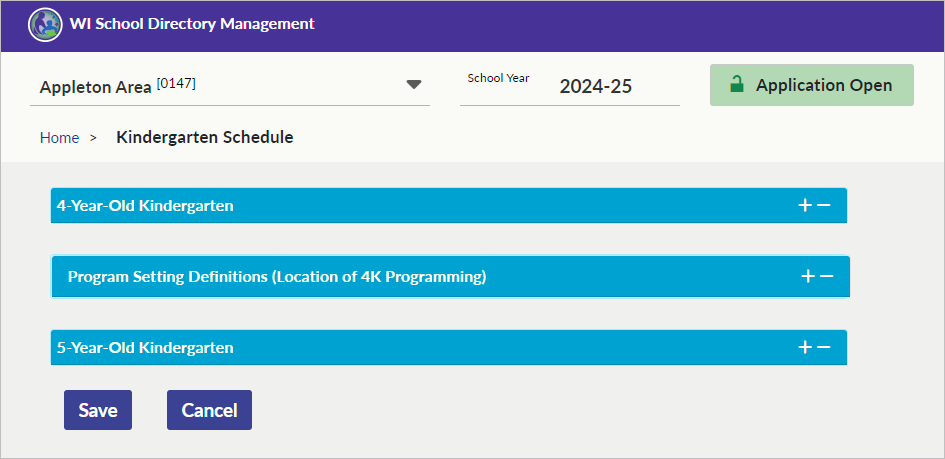
Each of the sections has an expander icon for this section. It looks like a ‘plus’ sign. The plus sign indicates there is more to see. Once clicked, the window expands and displays a list of options. Select what is available within your district. Click the “minus” sign to reduce that section back down to a header.
- Visit the Kindergarten Schedule data element page for more details.
4-Year-Old Kindergarten (K4)
There are 14 options available to choose from in this section. You may only select one of these options.
To Manage:

-
Make your 4-Year-Old Kindergarten selection from the list of options.
-
NOTE: If 'Other' was selected, you must add notes to describe. You are limited to 200 characters.
-
OPTIONAL: Minimize the 4-Year-Old Kindergarten header.
-
-
Move on to the Program Setting Definitions section.
Location of 4-Year-Old Kindergarten: Program Setting Definitions
There are thirteen options within options in this drop-down section. You may only select one of these options.
To Manage:

-
Make your Program Setting Definition (Location of 4K Program) selection from the list of options.
-
OPTIONAL: Add notes.
-
OPTIONAL: Minimize the Program Settings Definitions header.
-
-
Move on to the 5-Year-Old Kindergarten section.
5-Year-Old Kindergarten (KG)
There are three options available to choose from in this section. You may only select one of these options.
To Manage:

-
Make your 5-year-Old Kindergarten selection from the list of options.
-
OPTIONAL: Add notes.
-
OPTIONAL: Minimize the 5-Year-Old Kindergarten header.
-
-
Click the “Save” button at the bottom of the screen.
-
Click ‘Home’ from the breadcrumbs, and verify that the proper selections appear in the home screen Kindergarten Schedule tile.
-
Make corrections as needed.
-
Move on to the Public School tile from the home screen.
- Public Schools Tile
-
 The Public Schools tile displays on the top row, farthest to the right on the home screen.
The Public Schools tile displays on the top row, farthest to the right on the home screen.Notice the small number in brackets next to the header of the Public Schools tile (e.g., [38]). This is the total number of schools within your agency. Each school within your district will appear on the Schools screen when you click the ‘Manage’ icon.
The home screen tile displays the names of the first six, alphabetically listed schools in the district. Underneath these six schools is an indicator of how many more schools exist that are not displayed on this tile (e.g., + 32 More). This number added to the six schools on display should add up to the total number of schools in your district (e.g., 6 + 32 = 38 total schools).
Enter school level/building level data on the screens available from this tile. Each school needs to be updated each school year.
Click the ‘Manage’ icon to view the Schools screen.
Schools Screen:
This screen displays all of the public schools within your agency/district, displayed across two panels. The panel on the left side of the screen provides a search bar and a school type code. The panel on the right displays all of the schools in alphabetical order. Notice also that a number appears at the bottom of the results, indicating the total number of schools (e.g., 38 of 38 displayed).
To locate a school, you can scroll through the alphabetical listing on the right side of the screen. The search bar, however, allows you to locate a specific school in your district by typing the name. This helps larger school districts find a specific school more quickly.
You can also use the School Type filter to locate all the schools of each type (elementary, combined elementary/middle, middle school, high school). Clicking the school type from the left panel will display all of those school types in the right panel, alphabetically. When using this search method, a number will appear at the bottom of the results, indicating how many of the total schools belong to the type you searched (e.g., when this district clicks the high school type, search results display 9 of 38, meaning this district has 9 high schools).

To proceed with your data management of each school, you must edit this building level data one school at a time. Locate the school you want, and click on its hyperlinked name from the panel on the right. Notice how the breadcrumbs expand on the screen that now displays building level data for the school you have selected (e.g., Badger Elementary).
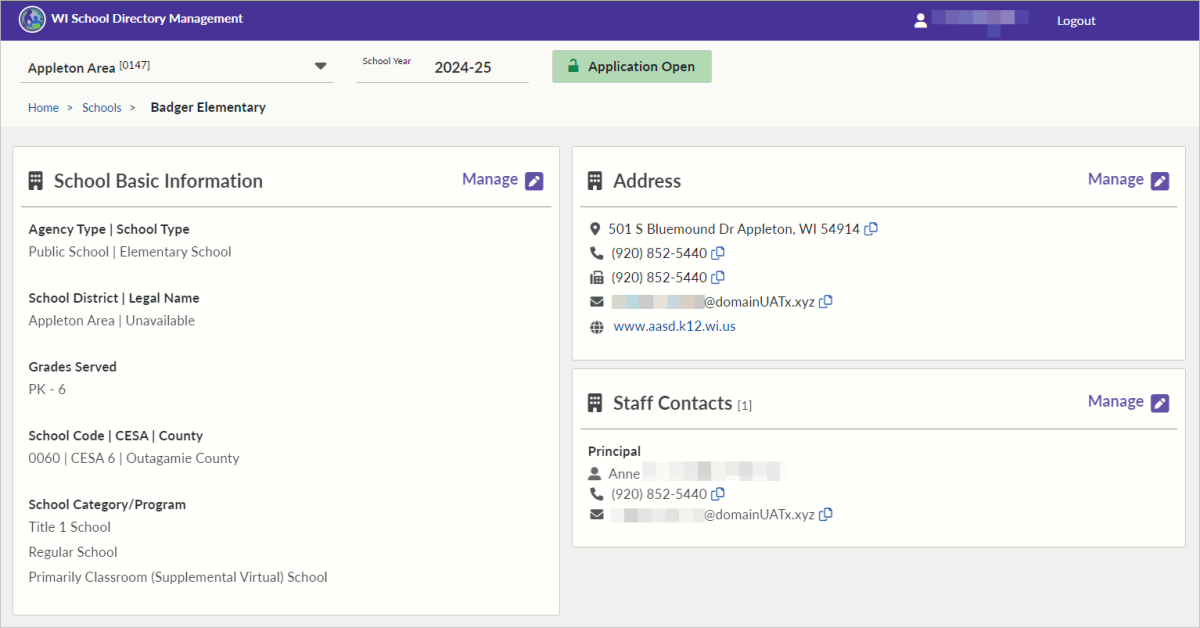
This school-specific screen displays three (familiar) tiles:
- School Basic Information
- Address
- Staff Contacts
The data displayed on these tiles is all school building level information.
Click the School Basic Information tile to view that screen.
School Basic Information Screen for a Selected School:
 This screen is editable. Make changes to any and all fields that require updating. This is the screen that allows schools to change their grade levels. Please pay close attention to the new methods for selecting PK.
This screen is editable. Make changes to any and all fields that require updating. This is the screen that allows schools to change their grade levels. Please pay close attention to the new methods for selecting PK. 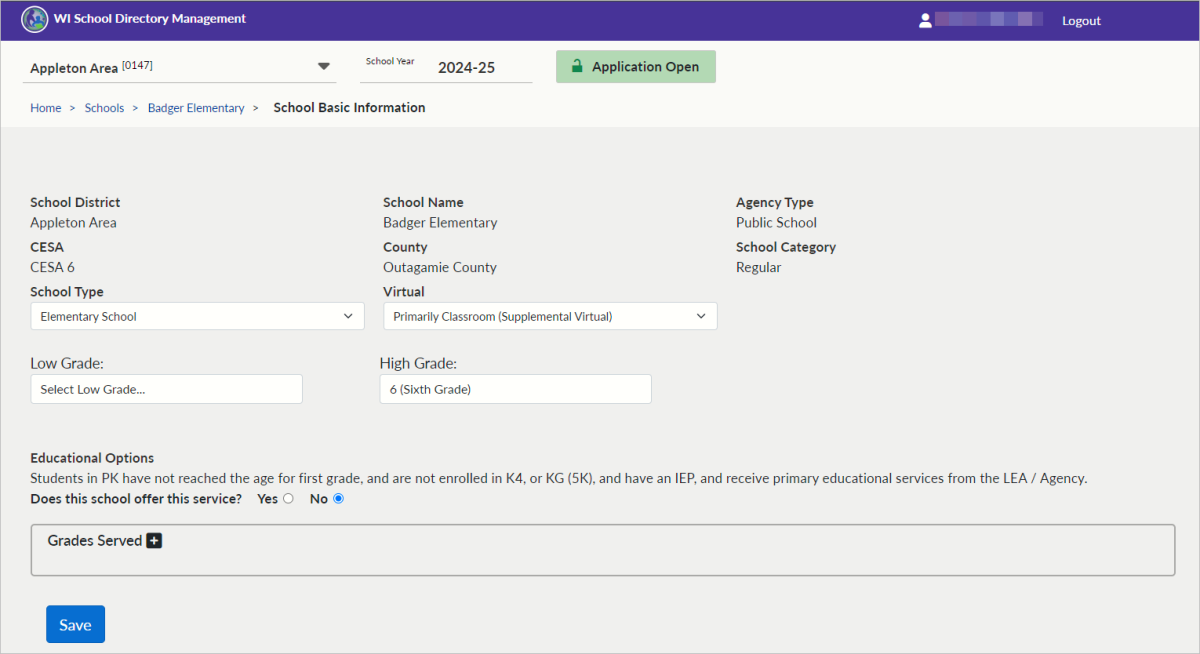
The top six fields are view only. If changes need to be made to the items bolded at the top (School District, Legal Name, Agency Type, LEA Code, CESA, and County), this must be requested through a Help Ticket. The person submitting this ticket must have the user role of “Directory Update” because this role signifies they have authority to request these changes.
- Agency Name data element page
- Legal Name data element page
- Agency Types that report through the School Directory Management Portal are defined on the School Directory Management Portal: User Guide landing page.
- LEA Code data element page
- CESA data element page
- County data element page
Use the drop-down menus to provide current and correct building-level information for the following data elements:
- School Type - School Type data element page
- Virtual School Status - Virtual School Status data element page
- Low Grade/High Grade - Low grade/High grade data element page
- These selections must be reviewed for the 2024-25 school year due to changes in the code PK. Read the Educational Service section for information on reporting PK.
- NOTE: PK is no longer listed in the Low Grade, High Grade drop downs. The removal of PK from the grade level list was done so because PK is not a grade level, as defined by state statute 115.02.
- The lowest possible grade is four-year-old kindergarten.
- These selections must be reviewed for the 2024-25 school year due to changes in the code PK. Read the Educational Service section for information on reporting PK.
- Educational Service: PK is not a grade. PK is a code, signifying students who: have not reached the age for first grade (aged 3, 4 or 5), and are not enrolled in K4 or KG, have an IEP, and receive primary educational services from the LEA/Agency.
- All elementary and combined schools located in a public school district are required to provide PK services.
- Public school districts that have elementary schools are obligated by both federal and state legislature to become FAPE responsible for students continuing their IEP and special education services after exiting County (CDEB) services.
- Any school that offers kindergarten (KG or K4) as a low grade by default must also offer PK.
- Unified high schools, high schools and middle schools should not offer PK services.
- Visit the Educational Service (PK) data element page for more details on PK.
- Visit the Grade Level Placement data element page for more details on PK.
- Visit the Grades Offered data element page for more details.
- Same as the view only, Basic Information screen, the Grades Offered section has an expander icon that looks like a ‘plus’ sign. The plus sign indicates there is more to see. Once clicked, the window expands and displays a list of all the grade levels your public school district offers.
- Click the check boxes to select or deselect grades for this specific school.
To Manage:

- Submit a Customer Services Team Help Ticket if any of the following are incorrect on your screen:
- School District, Legal Name, Agency Type, LEA Code, CESA, and County
- School Type: Make a selection from the drop down menu.
- Virtual: Make a selection from the drop down menu.
- Low Grade, High Grade: Adjust low grade and high grade.
- PK Educational Service: Select Yes or No using the radio button.
- PK is a federal requirement under FAPE (free appropriate public education) that must be offered by public schools/districts. All elementary and combined schools located in a public school district are required to provide PK services.
- Grades Offered: Adjust grades offered.
- Save changes.
- Click the School Name from the breadcrumbs, and move on to the Address tile.
School-specific Update for Address and Contact Screen:
 This screen is editable. Make changes to any and all fields that require updating.
This screen is editable. Make changes to any and all fields that require updating.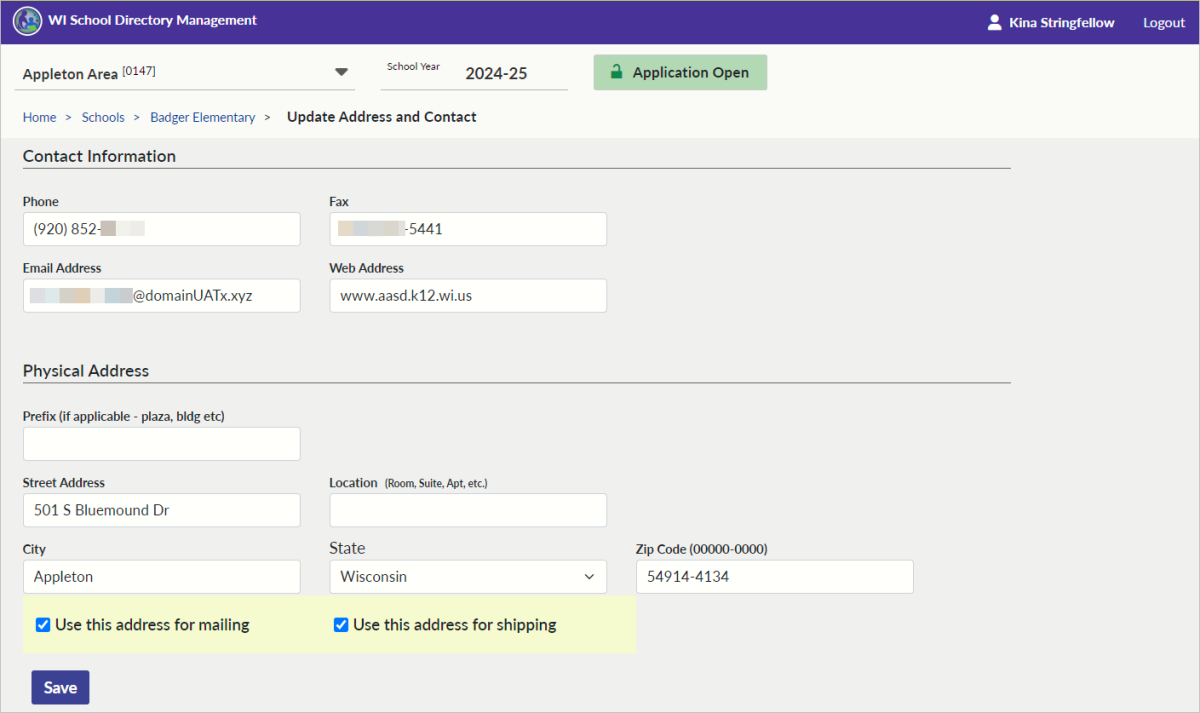
For the Contact Information section, remember to provide building level information for the following fields: Phone, Fax, Email, Web address.
For more details about these fields, please visit the Contact Information data element page.
To Manage:

-
Review the accuracy of your contact information for the front office of the school building, or for the building primary contact person.
-
Phone, Fax, Email address (e.g., for general inbox), Web address/URL for your specific school building
-
-
Move on to updating address information for this school.
There are also three address types to manage on this screen: physical, mailing, and shipping.
For the Physical Address section, remember to provide information specific to the school named in the breadcrumbs. Complete all of the following fields: Prefix, Street Address, Location, City, State, Zip Code.
For more details about these fields, please visit the Address data element page.
Notice the boxes at the end of the physical address section to repeat the physical address as either or both the shipping and mailing address. You may choose to click one, both, or neither of these boxes as they apply to your school building level needs.
- Mailing Address: check box available if same as physical address
- Shipping Address: check box available if same as physical address
If both boxes are left unchecked, you will need to enter information for both the mailing and shipping address.

To Manage:

-
Review the accuracy of your addresses: physical, mailing and shipping.
-
Either check the boxes to make the mailing/shipping address the same as the mailing address, or enter separate mailing/shipping address information.
-
Make sure you follow the details provided about location if your school’s location is in a difficult to locate area.
-
-
Save changes.
-
Click the School Name from the breadcrumbs, and confirm that everything in the Address tile is displaying correctly.
-
Move on to the Staff Contacts tile.
School-specific Staff Contacts Screen:
 This screen is editable. Make changes to any and all fields that require updating. Add any missing contact types indicated by notifications posted across the top of the screen for each school building.
This screen is editable. Make changes to any and all fields that require updating. Add any missing contact types indicated by notifications posted across the top of the screen for each school building.
For the Mandatory Contacts section, remember that you are now entering school building level contact information.
Mandatory Contacts for a Public School:- Public School Primary Contact: This is usually the Building Principal.
- Visit the Staff/Mandatory Contacts data element page for more information.
 Based on state statutes and other regulations, collecting contact information from various staff positions is required of DPI. These positions can and should be edited to ensure you submit current and accurate contact information to DPI.
Based on state statutes and other regulations, collecting contact information from various staff positions is required of DPI. These positions can and should be edited to ensure you submit current and accurate contact information to DPI.These same contacts cannot be deleted because they are required. As such, the edit icon is visible, but the trash can (‘delete’) icon is not available. When a specific contact type, such as the District Administrator, displays these icons, it indicates that it is a required position.
To Manage:

-
Review the accuracy of your mandatory contact information.Mandatory contacts for a public school district include:
-
Public School Primary Contact: This is usually the building principal.
-
-
Click the purple edit icon to make changes. Make sure all Staff Contacts have been managed and updated to reflect current school year data for the specific school.
-
Click the “+Add Contact” button to add any missing mandatory contacts.
-
Click the School Name from the breadcrumbs.
-
Confirm that everything appears accurately on the Staff Contacts tile for the Primary Contact Person: title, name, school phone number, email address.
Add Contacts Screen
 When clicking the “+ Add Contact” button from the Staff Contacts screen, the Add Contacts screen will display. This should be annotated in the breadcrumbs: Home > Schools > Name of Selected School > Staff Contacts > Add Contact.
When clicking the “+ Add Contact” button from the Staff Contacts screen, the Add Contacts screen will display. This should be annotated in the breadcrumbs: Home > Schools > Name of Selected School > Staff Contacts > Add Contact.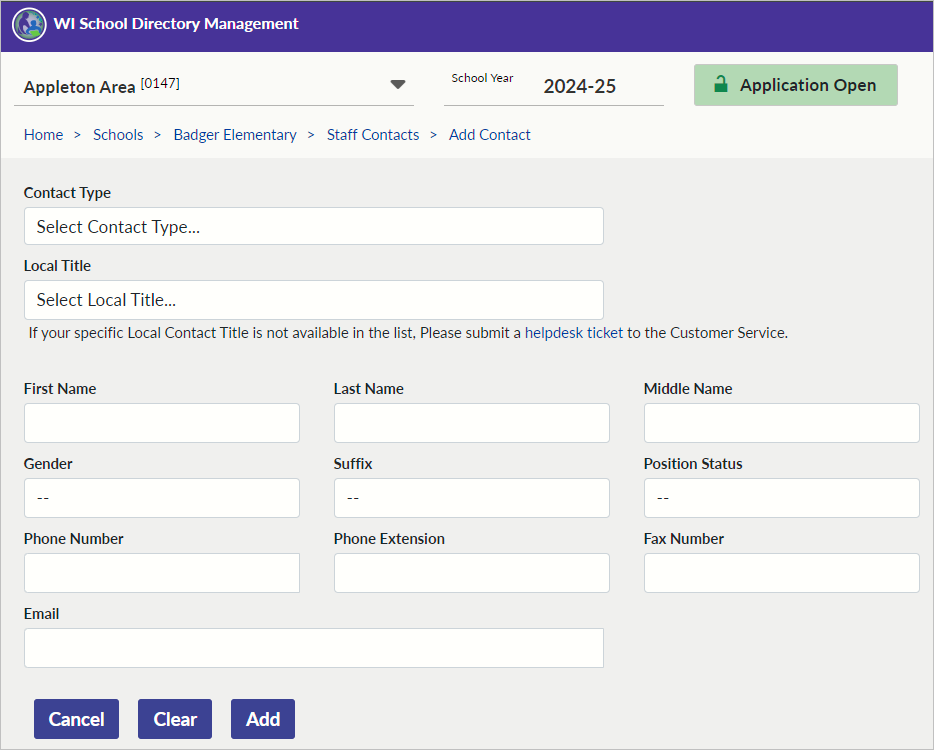
To add a new contact, complete the following steps:
- Select the Contact Type for all required mandatory contacts, especially if they are missing.
- Visit the Staff/Mandatory Contacts data element page for more information.
- Select an appropriate Local Title. If your specific Local Title is not available in the list, please submit a Help Ticket to the Customer Services Team.
- Enter: First Name, Last Name, Middle Name, Gender, Suffix, Position Status, Phone Number, Phone Extension, Fax Number, and Email for the current contact person. Items marked with an asterisk are required.
- For more details about these fields, please visit the Contact Information data element page.
- For position Status, if the position is neither vacant nor an interim, leave that field blank.
- Below these fields there will be three buttons: Cancel, Clear, Add.
- Click the “Add” button to save the new mandatory contact.
To Manage:

-
Add all fields for the required contact.
-
Return to the Staff Contacts screen using the breadcrumbs to make sure your new contact appears in the listing.
-
Repeat as needed until all contacts are listed.
-
Return to the Staff Contacts screen using the breadcrumbs to review the Other Contacts section.
Other Contacts
Below the list of mandatory contacts are additional positions that you can post as other contacts. Again, make sure you are only adding school building level contacts on this screen.
To Manage:

-
Ensure all other contacts listed are accurate and current.
-
Edit or delete as needed for an accurate display of building level staff positions
-
Return to the School-specific screen (e.g., Badger Elementary) to review that the Public School Primary Contact Person: name, school phone number, and email address all appear accurately in the Staff Contacts tile.
-
Click ‘Home’ from the breadcrumbs when all Staff Contacts have been managed and updated to reflect current school year data.
-
Move on to the 'Private Schools' tile.
Repeat the Last Three Steps for Each School in Your District
 REMEMBER: The individual within each local education agency with the user role “Directory Update” needs to update this information for EACH SCHOOL in the school district.
REMEMBER: The individual within each local education agency with the user role “Directory Update” needs to update this information for EACH SCHOOL in the school district.To Do This:

-
Click ‘Schools’ from the breadcrumbs, select the next school, and repeat the previous three steps (marked with the repeat icon) for school level information.
-
The table listing all of the schools has an Update Status column to help you keep track of completed work.
-
You can complete this work over a series of different sessions. The work you complete will be saved.
-
-
When all schools have been updated, click ‘Home’ from the breadcrumbs.
-
After all schools have been reviewed, confirm that Grades Offered on the Basic Information tile on the Home screen is correct for your school district.
-
Move on to the Private Schools tile.
-
Private Schools Tile
-
 This tile lists all of the private schools that exist within the geographical boundaries of the public district.
This tile lists all of the private schools that exist within the geographical boundaries of the public district.Notice the small number in brackets next to the header of the Public Schools tile (e.g., [13]). This is the total number of private schools within your public school district’s boundaries.
Each of these schools will appear on the screen when you click the ‘Report Private School Closings’ phrase.
Reporting Private School Closings Screen
This screen is editable. The changes made on this screen are for reporting to DPI any private schools that you know to have closed. DPI will verify these changes before altering the status of the school. We ask this to our public schools as a matter of convenience for reporting accuracy. We thank you for choosing to report the latest status of the private schools within your public school boundaries.
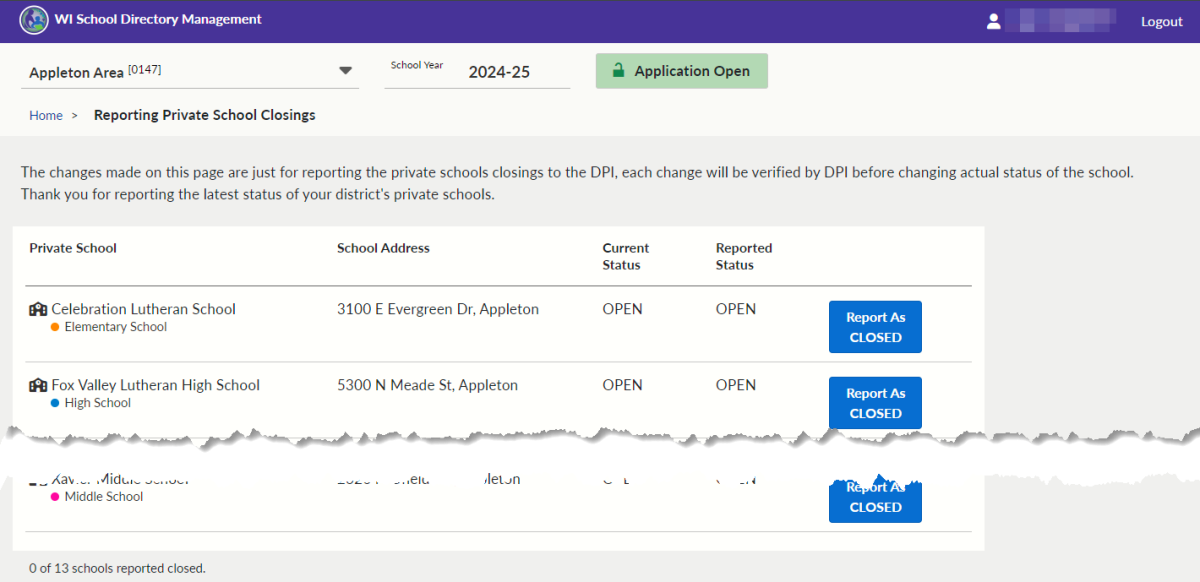
To Manage:

- Click ‘Report Private School Closings’.
-
Review the list of private schools.
-
OPTIONAL: For any school you know to be closed, click the “Report as CLOSED” button.
-
-
Click 'Home' from the breadcrumbs to return to the Home Screen.
- Return to Home Screen: Submit Review Button
-
As mentioned at the beginning of this checklist, the “Submit Review” button is the first item that appears on the Home screen and is the last item you should complete. Scan the Home screen to make sure there are no validation messages for data to be reviewed. Address all tiles/screens to correct the data and resolve the validation message.
Across the very top of the home screen is an instructional message.It reads:
Data has not been verified for the 2024-25 school year. Review the data on all tiles and subsequent screens, make changes as needed, and save your changes. Areas with missing mandatory data will display an error message. When done, click the Submit Review button to mark that your data has been managed.
OR
· Data submission in Progress, last update MM/DD/YYYY.
Click the “Submit Review” button only after you have reviewed (updated and saved) all data for the current school year. This indicates to DPI that you have clicked every tile from the Home screen, and reviewed the data on every screen, saving changes along the way.
Clicking this “Submit Review” button means it’s time to celebrate Data Quality! Woo Hoo!!
Once you click this button, you can still make changes with the SD Management Portal as needed until the application closes (typically, at the end of each calendar year). The application opens again within a few weeks of the closing.
- Visit the Submit Review data element page for more information.
For more information, visit the School Directory Management Portal: Annual Required Updates webpage.
- Please submit your feedback to the Customer Services Team if you have feedback or suggestions about this form or its corresponding webpages.
- If you have questions and need help from a Customer Services Team representative, please submit a WISE Help Ticket.
Didn't Find What You Needed?
The Customer Services Team is here to help!
Please submit a Help Ticket so we may better assist you.
Choose “School Directory Updates” from the Application dropdown, and one of our dedicated support staff will reach out to you.